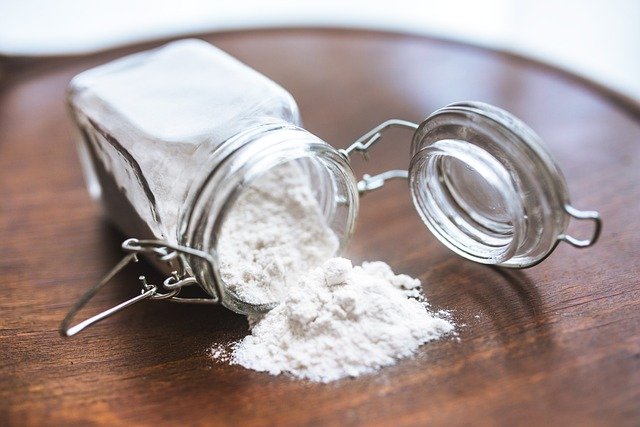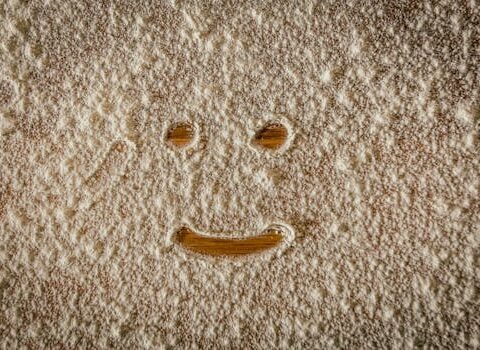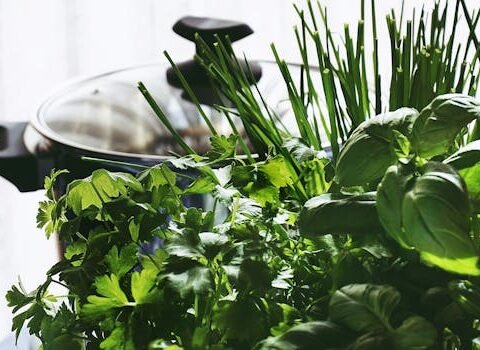Gluten-free flours offer a multitude of possibilities for preparing naturally gluten-free recipes or for replacing flours with gluten (wheat, rye, spelled and barley). In this article, find out which gluten-free flours to choose for successful preparations, whether for pastries, breads, sauces, or pasta. I hope this article will help you identify the flours best suited for your recipes, and offer you practical tips for cooking gluten-free with ease.
The different gluten-free flours
1. Rice Flour: Versatile and Light
Rice flour is undoubtedly the most popular gluten -free flours because of its light texture and its neutral taste. Prefer the full rice flour that contains more fibers and has a lower glycemic index.
- Use in baking : Rice flour is ideal for recipes for cakes, muffins, pancakes and biscuits .
- Tip : For a lighter texture, mix it with a small amount of starch flour (corn or tapioca).
2. Corn Flour: Perfect for Sauces and Breads
Known for its golden color and mild taste, corn flour is ideal for thickening sauces and providing a crispy texture.
- Use in sauces and breads : Use it to prepare corn pancakes, tortillas , and to thicken soups or sauces.
- Tip : Mix it with other flours for a better balance in gluten-free breads.
3. Buckwheat Flour: For a Rustic and Nourishing Flavor
This flour with a pronounced flavor is perfect for rustic preparations.
- Use in pancakes and pancakes : Buckwheat flour is ideal for Breton pancakes , pancakes and even certain breads.
- Tip : To soften its taste, mix it with rice flour.
4. Coconut Flour: Light and Aromatic
Rich in fiber and flavor, coconut flour is ideal for baking.
- Use in pastries and desserts : It is used in small quantities for gluten-free cakes, muffins and biscuits
- Tip : It absorbs a lot of liquid, so adapt your recipes by increasing the quantity of liquids (eggs, milk).
5. Tapioca Starch: For Soft Textures
This starch is perfect for giving lightness to preparations.
- Use in baking and bread : Add it to give flexibility to gluten-free breads and cakes.
- Tip : Mix it with other gluten-free flours for fluffier results.
6. Almond Flour: Rich and Nutritious
Bringing a subtle nutty taste, this flour is perfect for recipes rich in flavor.
- Use in baking : Almond flour is excellent for cookies, cakes and muffins .
- Tip : It is dense, so prefer to mix it with other flours for a lighter texture.
7. Chickpea Flour: For Savory Recipes
Known for its unique taste, chickpea flour is widely used in savory recipes and even in fried foods.
- Use in savory cooking : Ideal for donuts, pancakes, and pancakes .
- Tip : Its taste is strong, so don't hesitate to mix with another flour.
8. Sorghum Flour: Nutritious Alternative for Bread
This flour is high in protein and fiber, making it a popular choice for nourishing recipes.
- Use in bread : Use it in bread recipes for a texture that is close to classic bread.
- Tip : Mix with cornstarch to improve the texture and make it easier to rise.
9. Millet Flour: Sweet and Nutritious
Millet flour is light and has a slightly sweet taste, ideal for sweet preparations and breads.
- Use : Ideal for breads , cakes, and muffins .
- Tip : It mixes well with other flours to lighten the texture of preparations.
10. Amaranth Flour: Protein and Unique
With its slightly earthy taste, amaranth flour is perfect for adding depth to savory and sweet dishes.
- Use : Perfect for breads, pancakes, and pancakes .
- Tip : Use it in addition to another flour, as it has a dense texture.
11. Lentil Flour: Protein and Slightly Nutty
Lentil flour is rich in protein, perfect for savory preparations.
- Use : Ideal for pancakes , thickened soups and fritters .
- Tip : Use in combination with neutral flours to reduce its taste.
12. Potato Starch: Lightness and Elasticity
This starch helps lighten and make cakes, muffins, and breads soft.
- Use : Perfect for thickening sauces or giving lightness to pastries .
- Tip : Mix it with flours like rice flour for better textures.
13. Cornstarch: Versatile and Essential
Cornstarch is an excellent base for light baked goods.
- Use : Ideal for sauces, cakes, and pastry creams .
- Tip : Use it in small quantities to avoid an overly sticky texture.
14. Arrowroot: Sweet and Digestible
Arrowroot is a mild starch that adapts well to savory and sweet recipes.
- Use : Ideal for thickening sauces, creams, and soups .
- Tip : Use it in transparent sauces or in combination with other starches.
15. Teff Flour: Fine and Slightly Sweet
Originally from Ethiopia, teff flour is naturally gluten-free and provides a mild, slightly sweet flavor.
- Use : Ideal for pancakes, flatbreads, and pastries .
- Tip : Mix it with other flours to avoid a too dense texture.
16. Chestnut Flour: Rich and Fragrant
With its sweet and delicate taste, chestnut flour is perfect for sweet recipes.
- Use : Ideal for pancakes, cakes, and muffins .
- Tip : It is very absorbent, so use it in small quantities and mix with lighter flours.
17. Cassava Flour: Light and Soft Texture
Cassava flour is one of the most neutral and versatile flours.
- Use : Perfect for breads, tortillas, and cakes .
- Tip : Mix with starches for softer textures.
What flours are mainly used in the world?
The types of flours used in world cuisines vary depending on cultures, climates and available local ingredients. Here is an overview of the countries and continents that use certain flours dominantly.
1. Wheat Flour (containing gluten) – Worldwide
- Distribution : North America, Europe, Middle East
- Use : Wheat flour is one of the most widespread, used in the manufacture of bread, pasta, pastries and cakes. Wheat is a staple crop in North America, Europe and many parts of the Middle East.
2. Corn Flour – Latin America and Africa
- Distribution : Mexico, Central America, South America, East and South Africa
- Use : Corn flour is a staple ingredient in Mexico (tortillas) and other Latin American countries. In Africa, it is used to prepare dishes like ugali in East Africa or pap in South Africa.
3. Rice Flour – Asia
- Distribution : Southeast Asia, Japan, China, Korea, India
- Use : Widespread in Asia, rice flour is used for recipes such as Japanese rice cakes, Asian noodles, and gluten-free pastries. It is also common in the preparation of tempura and other breaded dishes in Japan.
4. Millet Flour – Africa, Asia, Eastern Europe
- Distribution : West Africa, India, China, Eastern Europe
- Use : In West Africa, millet is used to prepare porridges or flatbreads. In India, millet flour (ragi) is common in pancake recipes. In Eastern Europe, it is sometimes used for traditional breads.
5. Buckwheat Flour – Europe and Asia
- Distribution : France (Brittany), Russia, Japan, Korea
- Use : Buckwheat flour is popular in Brittany for pancakes, in Russia for blinis, and in Japan for soba (buckwheat noodles). In Korea, it is used to make pancakes and noodles.
6. Cassava Flour (or Tapioca) – Latin America, Africa, Southeast Asia
- Distribution : Brazil, West and East Africa, Southeast Asia
- Use : In Brazil, cassava flour is used for pão de queijo. In Africa, it is used in the composition of many dishes such as fufu. In Southeast Asia, it is often used as a thickener and in desserts.
7. Chickpea Flour – Middle East, Mediterranean, India
- Distribution : India, Middle East, Mediterranean Europe
- Use : In India, this flour is used for dishes like pakora and besan ladoo. In the Middle East and the Mediterranean, it is used to make pancakes (socca in France, panelle in Italy).
8. Sorghum flour – Africa, India
- Distribution : West Africa, East Africa, India
- Use : In West and East Africa, sorghum is used for porridges and pancakes. In India, it is commonly used for gluten-free roti.
9. Teff flour – East Africa
- Distribution : Ethiopia, Eritrea
- Use : In Ethiopia, teff is used to prepare injera, a fermented, spongy flatbread, an essential part of Ethiopian cuisine.
10. Almond Flour – Europe, Middle East, United States
- Distribution : Middle East, Europe, United States
- Use : In Europe and the Middle East, it is used in traditional pastries such as macaroons, amaretti, and tarts. It is also popular in the United States for gluten-free baked goods.
11. Potato Starch – Europe, United States, Japan
- Distribution : Europe, United States, Japan
- Use : Used as a thickener in sauces, soups and desserts. In Japan, it is used in the preparation of certain recipes such as dango.
12. Coconut Flour – Southeast Asia, Caribbean, United States
- Distribution : Philippines, Indonesia, Caribbean, United States
- Use : Widespread in Southeast Asia, coconut flour is used in pastries and to thicken curries. It is also popular in gluten-free recipes in the United States.
13. Chestnut Flour – Southern Europe
- Distribution : France (Corsica), Italy
- Use : In Corsica and Italy, chestnut flour is used for recipes like castagnaccio and crepes, providing a natural sweet taste and dense texture.
These flours illustrate different culinary cultures and their adaptation to local ingredients to create unique recipes.
Gluten-free bread and flour
Bread usually made by mixing flour and water and then baked into a firm, light dough. Essential in many cultures, bread comes in multiple varieties depending on ingredients, rising methods, and baking techniques. Traditionally, bread is leavened through yeast fermentation or natural sourdough, which creates air bubbles and a soft crumb. However, there are also unleavened breads, such as flatbreads, which remain dense.
In gluten-free bread, wheat or rye flours are replaced by flours such as rice, corn or millet, as well as binding agents to compensate for the absence of gluten. As a universal food, bread accompanies various dishes, is eaten alone or garnished, and often symbolizes conviviality and sharing.
Gluten-free flours do not rise easily because they lack gluten, a protein that creates an elastic network capable of retaining air bubbles and giving an airy texture to breads and pastries. In traditional recipes, gluten is essential to obtain a light and well-developed crumb. Without this ingredient, gluten-free flours produce denser, crumbly doughs, making rising more difficult.
Tips for Proofing Gluten-Free Bread
To obtain leavened and airy gluten-free bread, it is important to add ingredients that imitate the properties of gluten by providing structure and elasticity:
- Gums (xanthan gum or guar gum) : These thickening and gelling agents play a crucial role in the texture of gluten-free breads. By adding 1 to 2 teaspoons of xanthan gum or guar gum to gluten-free flour, you strengthen the dough, helping to capture and retain air bubbles, which promotes better rising.
- Eggs : Eggs provide both moisture and structure. They help improve the elasticity of the dough and add aeration. An egg or two in the recipe helps give gluten-free bread a lighter crumb.
- Leavening agents : In addition to yeast, it is recommended to add a small amount of baking soda and cider (or lemon) vinegar. This combination reacts by producing carbon dioxide, which helps expand the dough. Add 1 teaspoon of baking soda and 1 tablespoon of vinegar for better rising.
- Warm water and sugar : Yeast needs heat and sugar to activate and rise properly. Mix the yeast with lukewarm water (around 35-40°C) and a little sugar to start fermentation before incorporating it into the dough. This gives a boost to the rising of gluten-free bread.
- Psyllium: To make gluten-free bread rise and obtain a soft crumb, psyllium is a very useful ingredient. Psyllium is a plant fiber, often used in powder form, which has gelling and absorbent properties. Psyllium, by absorbing a large quantity of water, forms a viscous gel that imitates the elasticity of gluten and provides cohesion to the dough, thus helping to obtain a more airy and less crumbly bread. Add about 1 to 2 tablespoons of psyllium per 500 g of gluten-free flour. Mix the psyllium with water before incorporating it into the dough.
Other Tips for Airy and Slightly Leavened Gluten-Free Bread
- Let the dough rise longer : Without gluten, it may take longer to rise. Let the dough rise until doubled in volume.
- Gluten-free flour blend : Combine flours like rice, millet, and sorghum with starches (corn, potatoes, tapioca) for a lighter texture.
These tips will help you obtain a well-risen and soft gluten-free bread, with a texture close to classic bread.
Breads of the world
There are several types of traditional breads around the world that are naturally gluten-free, because they use flours made from grains and seeds that do not contain gluten, such as corn, rice, millet, and buckwheat. These are breads, but often very different from our French breads: they can be spongy, flat, crepe or pancake shaped. Here is a list of these breads and their origins, ideal for exploring gluten-free alternatives around the globe.
1. Injera (Ethiopia and Eritrea)
Injera is a fermented flatbread made from teff flour , a naturally gluten-free grain. This spongy bread is essential in Ethiopian and Eritrean cuisine and serves as a base to accompany various dishes.
2. Arepa (Venezuela and Colombia)
Arepas are thick pancakes made from corn flour . They can be grilled, fried or baked and are often topped with cheese, avocado or meat. Their soft texture makes them an excellent bread substitute.
3. Corn Tortilla (Mexico)
Corn tortillas are made from nixtamalized corn flour . They are very popular in Mexico and Central America and are used to prepare tacos, quesadillas and other Mexican dishes.
4. Socca (France, Nice region)
Socca is a pancake made from chickpea flour and water, cooked in the oven or in a pan. It is popular in the south of France, particularly in Nice, and is eaten hot, often with pepper.
5. Farata or Roti (Mauritius and India)
This version of roti, called farata in Mauritius, is made with rice flour or millet flour. In some Indian regions, rotis with buckwheat or millet flour for gluten-free variations.
6. Dosa (India)
Dosa is a thin, crispy pancake made from rice and lentils , very popular in South India. Its texture is slightly crispy, and it is often served with chutneys or sambar.
7. Chakra Pitha or Tandalachi Bhakri (India, Maharashtra)
This Indian flatbread is made from rice flour and is often eaten in the state of Maharashtra. Tandalachi Bhakri is thick and slightly crispy, ideal to accompany curries.
8. Buckwheat pancakes (France, Brittany)
Traditionally prepared in Brittany, buckwheat pancakes are made from buckwheat flour . Naturally gluten-free, they are perfect for savory pancakes with varied toppings like ham, cheese and eggs.
9. Fufu (West Africa)
Fufu is a hearty paste made from cassava , plantains , or other roots. It often accompanies dishes with sauce in several West African countries, such as Ghana, Nigeria, and Benin.
10. Pão de Queijo (Brazil)
Pão de queijo is a cheese roll made with tapioca starch . It is soft and slightly crispy on the outside. Traditionally Brazilian, it is highly appreciated for its unique taste and texture.
11. Masa (Guatemala)
Masa is a flatbread made from corn flour that is cooked on a griddle. Similar to tortillas, it is thick and is served to accompany stews or soups.
12. Buckwheat Blinis (Russia)
These small Russian pancakes are prepared with buckwheat flour and often served with smoked salmon, crème fraîche, and fish roe. They are naturally gluten-free and very tasty.
13. Millet Chapati (India, Rajasthan)
In some parts of India, chapatis are made from millet flour . It is an alternative to classic chapati and an excellent source of nutrients for those following a gluten-free diet.
14. Lefse (Norway)
Lefse is a Norwegian flatbread traditionally made with potatoes and sometimes rice flour to thicken it. It’s a soft pancake that can be topped with butter or sugar.
These gluten-free breads allow you to diversify your diet while exploring the flavors of the world. Try preparing them at home using traditional techniques!
The flours that “rise” best for bread
To obtain a good rise in gluten-free bread, sorghum flour and teff flour are particularly suitable. These flours, rich in proteins, provide structure and promote better dough hold, allowing a more satisfactory rise compared to other gluten-free flours. Here is how they behave and some tips for optimizing their use in gluten-free bread.
1. Sorghum flour:
Sorghum flour has a good protein content, which helps retain air bubbles during rising, even in the absence of gluten. It is mild in flavor and works well in blends with starches like tapioca or potato, which lighten the texture.
2. Teff flour:
Originally from Ethiopia, teff flour is also rich in protein and fiber, which contributes to a more stable rise. Its slightly sticky texture helps the dough better capture air and obtain an airy crumb, especially when mixed with starches.
Tips for better rising of gluten-free bread dough:
- Add xanthan gum or guar gum to improve the elasticity and hold of the dough.
- Stir in a leavening agent like baking soda combined with vinegar to generate additional air bubbles.
- Use a blend of flours : combining sorghum, teff, and tapioca/potato starch helps achieve a balanced texture and rise.
These flours, although gluten-free, allow you to make larger and softer breads with the right adjustments.
Basic doughs: the most suitable gluten-free flours
To prepare gluten-free pasta, it is important to choose flours that provide a texture and hold similar to classic pasta. Here are the best gluten-free flour options for making shortcrust pastry, shortcrust pastry, puff pastry and fresh homemade pasta.
1. For a Gluten-Free Shortbread Dough
Shortbread dough needs flours that provide crunch and a crumbly texture. A balanced mixture is essential to obtain a dough that holds together while melting in the mouth.
- White rice flour : Its light texture is ideal for adding crunch without weighing down the dough.
- Corn or potato starch : These starches allow you to obtain a more creamy and light result, while reinforcing the structure of the dough.
- Almond flour (optional): Add a small amount of almond flour to enrich the flavor and enhance the crumbly texture.
Tip : Mix around 60% rice flour, 20% corn or potato starch, and 20% almond flour for a perfectly crispy gluten-free shortcrust pastry.
2. For Gluten-Free Shortcrust Pastry
Shortcrust pastry, used for savory and sweet tarts, requires a soft texture that holds together well.
- Whole rice flour or millet flour : These flours are slightly denser than white rice flour, which gives a good structure to the shortcrust pastry.
- Cornstarch or tapioca starch : Starches add lightness and help make a smoother, more manageable dough.
- Psyllium (optional): Add a teaspoon of psyllium to add flexibility to the dough, thus helping it to spread and hold when cooking.
Tip : Opt for a mixture of 70% brown rice or millet flour and 30% starch to obtain a balanced gluten-free shortcrust pastry, perfect for pies.
3. For Gluten-Free Puff Pastry
Gluten-free puff pastry is a little more complex to make due to the absence of gluten, which plays an important role in the formation of the layers of dough. However, by using appropriate flours and techniques, satisfactory flakiness can be obtained.
- White rice flour : Its lightness is ideal for good flakiness.
- Corn or potato starch : Essential to lighten the dough and facilitate the formation of flaky layers.
- Tapioca flour : It provides slight elasticity, essential for the puff pastry to hold together during successive foldings.
- Xanthan or psyllium gum : Add a small amount of xanthan gum (about 1/2 teaspoon) or a teaspoon of psyllium to give structure to the dough and achieve successful puffing.
Tip : Mix 50% white rice flour, 25% corn or potato starch, and 25% tapioca flour, with a pinch of xanthan gum. Make sure you follow the folding technique carefully for optimal lamination.
4- For Fresh Homemade Pasta
To make fresh homemade gluten-free pasta , it is important to choose flours that will provide elasticity and good hold. Although gluten is lacking to give this typical texture, a good mix of flours and the addition of binding agents make it possible to obtain homemade dough that is tasty and easy to work with.
- White Rice Flour or Whole Rice
- Rice flour is light and neutral in taste, perfect as a base for gluten-free pasta. It gives a smooth texture that holds up well when cooked.
- Suggested proportion : 60% of the total mixture.
- Tapioca Flour
- Tapioca provides a certain elasticity and improves the texture of gluten-free pasta by making it more supple. It also helps bind ingredients together, making shaping easier.
- Suggested proportion : 20% of the total mixture.
- Corn Flour or Millet Flour
- These flours provide structure and a pleasant taste to gluten-free pasta. The corn flour will give a nice golden color, while the millet adds a subtle, sweet note.
- Suggested proportion : 10% of the total mixture.
- Potato Starch
- Potato starch gives lightness to the pasta and provides a softer texture.
- Suggested proportion : 10% of the total mixture.
Binding Agents for Gluten-Free Pasta
To compensate for the absence of gluten, it is recommended to add a binding agent which will help give elasticity and suppleness to the dough:
- Psyllium : Add 1 to 2 teaspoons of psyllium to create a light gel, which will give the pasta a good hold and prevent it from falling apart when cooking.
- Xanthan Gum : A small amount (1/2 teaspoon) helps make the dough more manageable and elastic.
Tips: Tips for Successful Homemade Gluten-Free Pasta
Add a touch of olive oil : A spoonful of oil in the dough can add softness and prevent the pasta from drying out.
Don't hesitate to adjust the hydration : Gluten-free dough can sometimes require a little more water to make it workable.
Use fresh eggs : They help bind the dough and improve its texture.
By following these tips, you will obtain fresh gluten-free pasta close in texture to traditional pasta, and ideal for all your pasta recipes.
There you go, you know everything about gluten-free flours: now there's more to it!!!



